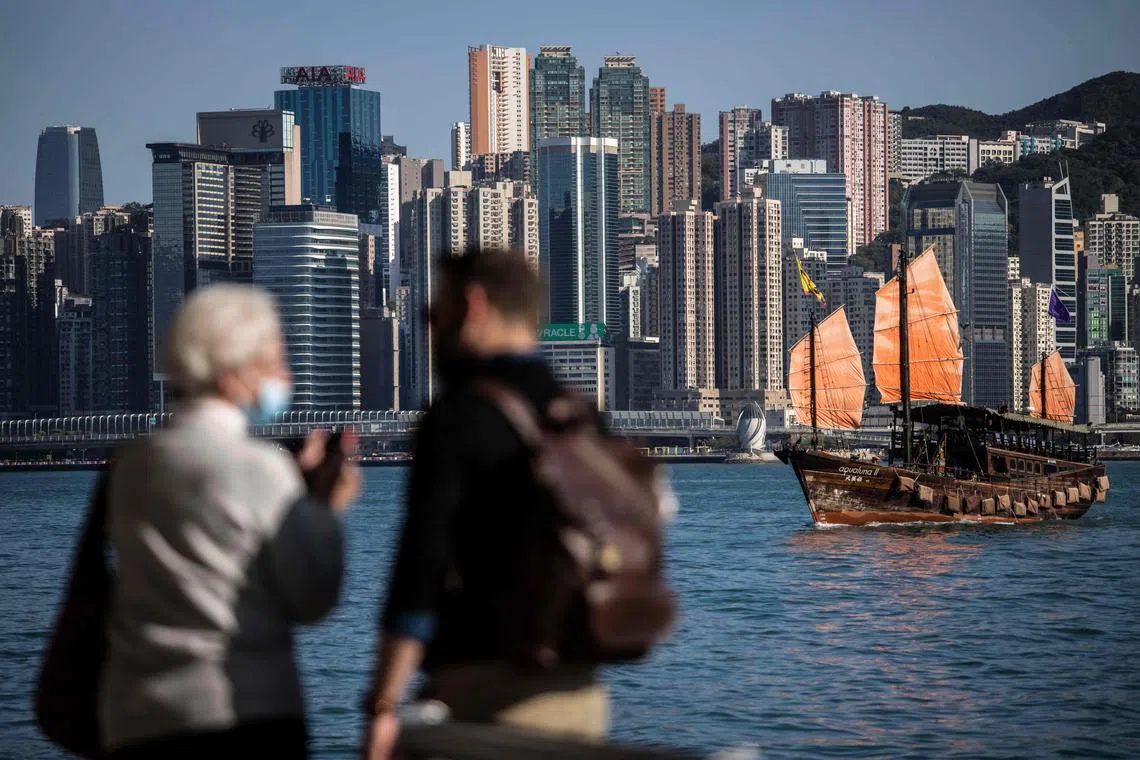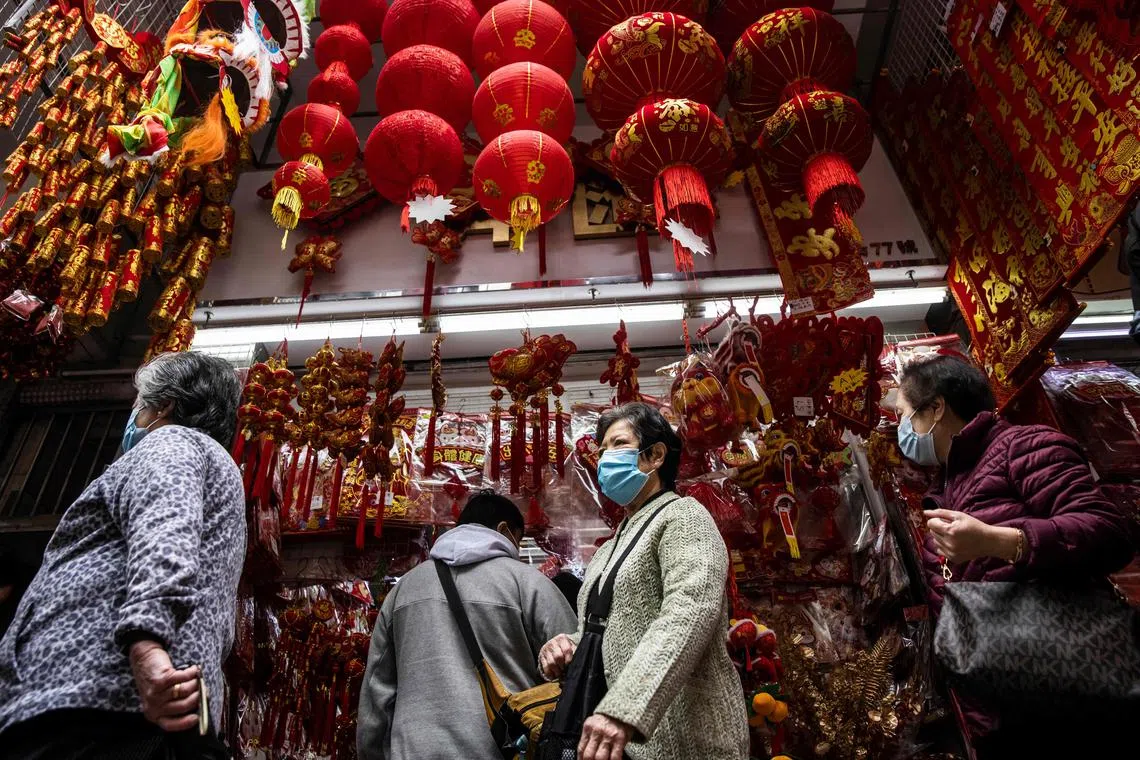Hong Kong worker shortage ruins reopening for restaurants and shops
Sign up now: Get insights on Asia's fast-moving developments

Hong Kong’s services industries are ill-equipped to benefit from an expected increase in business as the city reopens because they are struggling to convince workers to return.
PHOTO: AFP
Follow topic:
HONG KONG – Hong Kong’s services industries are ill-equipped to benefit from an expected increase in business as the city reopens because they are struggling to convince workers to return.
Restaurant owner Yeung is one of them: He is finding it hard to find employees, especially chefs, after losing workers during the Covid-induced downturn.
“My chefs, if they quit now, they can find a job the next day. It’s hard to keep them here,” said Mr Yeung, 30, who preferred not to use his full name. He added that at one point he had to cut wages for his employees by 30-40 per cent.
Hong Kong is banking on an influx of visitors to kickstart an economy that likely contracted 3 per cent last year.
Hiring has been tricky as prospective workers switch to industries they feel are less volatile, or as they leave the city altogether.
Even if companies resolve their short-term hiring challenges, economists warn that the long-term outlook is grim.
“Several structural factors are at play, such as a shrinking local workforce, current labour importation policy, and the capacity to upskill and retrain local workers,” said Dr Lloyd Chan, senior economist at Oxford Economics. Even with an open border, he added, those issues are not likely to be resolved soon.
Job struggles
The immediate crunch stems from a tough few years for Hong Kong, where tourism-dependent industries were pummelled first by anti-government protests in 2019 and then by Covid-19 curbs that shut out visitors for years.
Many hotels and restaurants were forced to shorten hours for workers, reduce pay, let employees go or shutter entirely as business suffered.
While the unemployment rate is still higher than it was in 2018, it has moderated in recent months. The rate dropped last month to 3.5 per cent, the Census and Statistics Department said on Thursday. That is the lowest rate since January 2020, the start of the pandemic.
But the improvement has not necessarily translated into good news for services industries, as former employees see little incentive to return.
“I think I won’t go back to the industry anymore,” said 28-year-old Lau, who quit her job as a telephone operator for a luxury hotel company early 2022 because of its vaccination policy.
Since then, she has been working as an office administrator for a property management company.
“The benefits, the salary, and the working hours are much better than the hospitality industry,” she said.

Hong Kong is banking on an influx of visitors to kickstart its economy, but its tourism-dependent industries have suffered following anti-government protests and Covid-19 curbs.
PHOTO: AFP
Concerns about job security continue to be an issue for former hospitality workers, according to Ms Winnie Chan, association manager of the Federation of Hong Kong Hotel Owners.
“Many do the same operational jobs just in other fields, often viewing those industries as more stable so they won’t come back,” she said.
Data show that even as the jobs returned, they are not being filled.
The number of job listings in the city topped 45,000 in October, according to a report in January from Moovup, a company that specialises in advertising jobs for front-line industries. The figure is more than double the number last March.
“With an abundant choice of work opportunities, front-line workers currently have more bargaining powers, unlike during the early stages of Covid in 2020,” said Mr Geoffrey Yau, co-founder and chief executive of Moovup.
That has also translated into an increase in wages. The overall monthly starting salary for a full-time worker was HK$15,000 (S$2,531) in December, 7.1 per cent higher than it was at the start of the year, Moovup data show.
A continued increase in costs would hurt profit margins for employers, Mr Yau said.
Aging populace
In the short-term, the government should set up a fund to help the hard-hit tourism industry with covering expenses and staff-related expenditure, said Mr Perry Yiu, the city’s tourism lawmaker.
An ageing population and exodus of younger people is exacerbating the tightness in the job market.
The number of residents aged 29 and below dropped to 24.1 per cent of the total population midway through 2022, from 27.8 per cent four years ago, according to data by Hong Kong’s Census and Statistics Department. The percentage of residents aged 65 or above increased to 20.9 per cent from 17 per cent.
Women having fewer children mean the situation is likely to worsen over time unless Hong Kong can import more labour. The birth rate in 2021 was the lowest on record going back to 1971.
At the same time, the city’s population fell by about 216,000, or 2.8 per cent, to roughly 7.3 million since 2020.
Since August 2018, Hong Kong’s labour force has dropped about 5 per cent to 3.8 million people, according to the latest official figures.
Finding solutions

Hong Kong’s labour shortage has been exacerbated by an aging population as well as an exodus of younger people.
PHOTO: AFP
One answer to the city’s ageing population is to encourage those aged 65 and older to participate longer, said Ms Aries Wong, an expert on Hong Kong’s economy at Hong Kong Baptist University. “Measures that promote digitalisation, automation...and thus productivity could also help alleviate the negative effect of those industries affected by higher wages.”
Giving companies more incentives to add internship positions and practicum hours are other longer-term solutions, said the lawmaker Mr Yiu. Another option is importing more labour from the mainland and overseas.
Businesses are allowed to import workers to fill jobs they face “genuine difficulties” recruiting for locally, according to city labour rules. But the number is small, with about 3,000 low-skilled workers having been imported to the city in 2021. That is about 1 per cent of the number of similar foreign workers that rival Singapore brought in to fill labour-intensive jobs like construction, or other semi-skilled workers.
The solution to the city’s labour market woes “would depend on the extent Hong Kong can attract non-local skilled workers”, said Dr Vera Yuen, economic lecturer at the University of Hong Kong’s Business School.
Rolling out policies or initiatives to increase the supply of low-skilled workers is not a government priority, according to a government official who requested anonymity in order to speak freely.
Asked about the manpower issues, a government spokesman said the challenges were “broad based”, and that “many sectors” are facing shortages.
“We are prepared to implement measures including provision of accommodation support for strategic industries” like innovation and technology, the spokesman said, adding that the government would listen to the views of and “put forward solutions having regard to the situation of individual sectors”.
Still, business owners are betting a rise in mainland tourists will boost the industries long-term growth prospects and convince enough workers that the sector is stable again. There were already 998,000 applications for entry permits to Hong Kong or Macau from mainland Chinese as of Jan 13, up 147.6 per cent from before the reopening.
“If business picks up, more people will be attracted back to our field,” said Ms Chan from the hotel owners federation. “They will foresee that the future of the industry is good, that we can raise the wages and maybe they will come back to our field.”
The risk for workers to return may be too great. Mr Yeung plans to close his restaurant soon because business has yet to improve.
“I just don’t see the business getting better in six-to-eight months and that for a restaurant is a very long timeline for recovery,” Mr Yeung said. “The numbers haven’t added up.” BLOOMBERG

